Financial Accounting Theory: Fair Value Accounting Analysis
VerifiedAdded on 2023/05/29
|10
|2262
|206
Essay
AI Summary
This essay presents a critical analysis of fair value accounting, examining its pros and cons within a globalized economic context, referencing the article by Antonio Marra. It discusses the advantages of fair value accounting, such as providing timely and accurate valuation based on current market conditions, enhancing the informative power of financial statements, and enabling a more realistic assessment of income and asset values during economic downturns. However, it also addresses the disadvantages, including potential for large value fluctuations, negative impacts on company financials and investor satisfaction, and the subjectivity involved in fair value measurements. The essay further explains the three-tier process used in fair value application, emphasizing the preference for market-based measures and the importance of judgment in continuous asset and liability valuation. Finally, it highlights the qualitative characteristics of financial information—relevance, faithful representation, understandability, comparability, and timeliness—and concludes that while fair value accounting has its limitations, it remains a crucial concept in modern accounting practices.
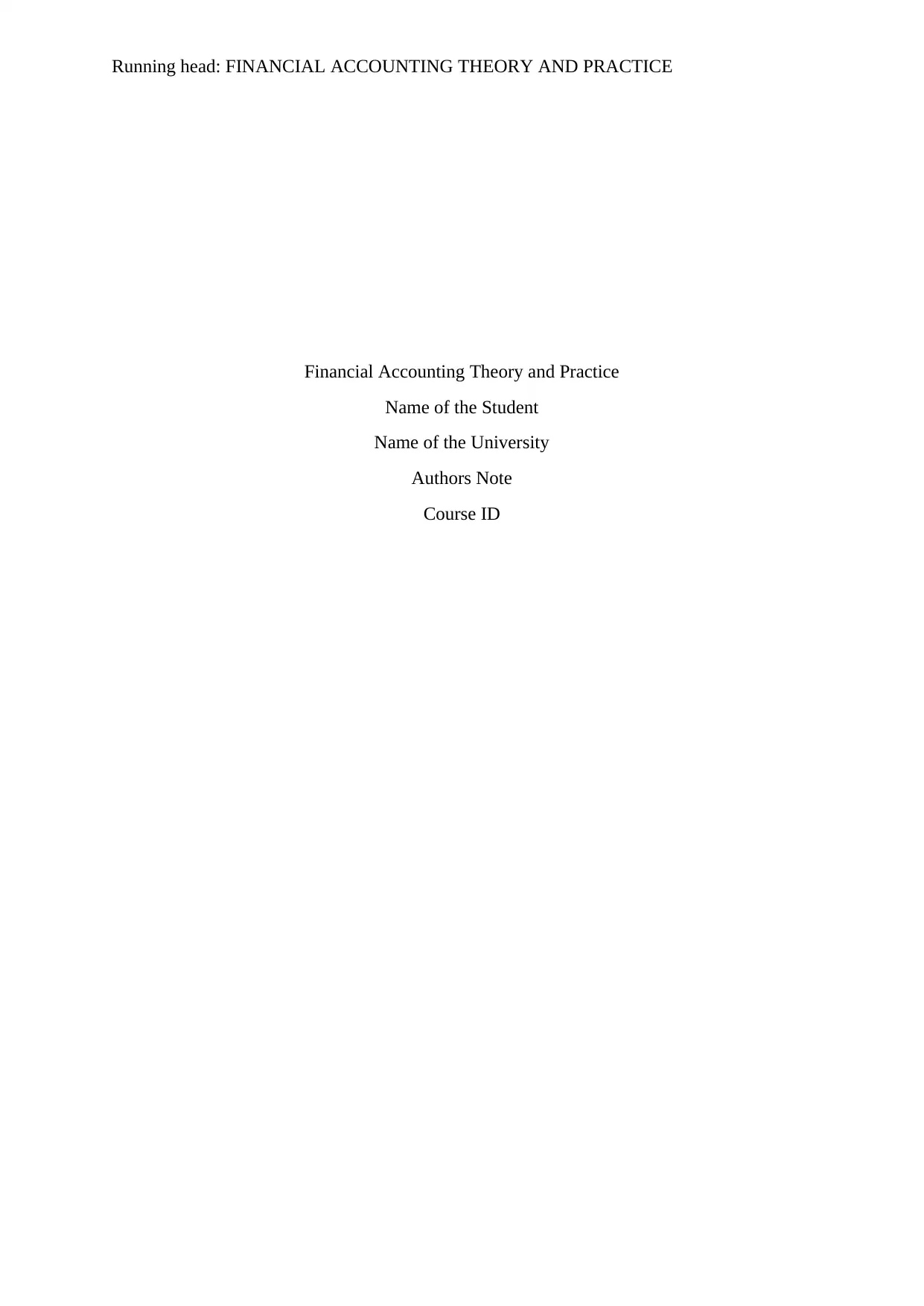
Running head: FINANCIAL ACCOUNTING THEORY AND PRACTICE
Financial Accounting Theory and Practice
Name of the Student
Name of the University
Authors Note
Course ID
Financial Accounting Theory and Practice
Name of the Student
Name of the University
Authors Note
Course ID
Paraphrase This Document
Need a fresh take? Get an instant paraphrase of this document with our AI Paraphraser
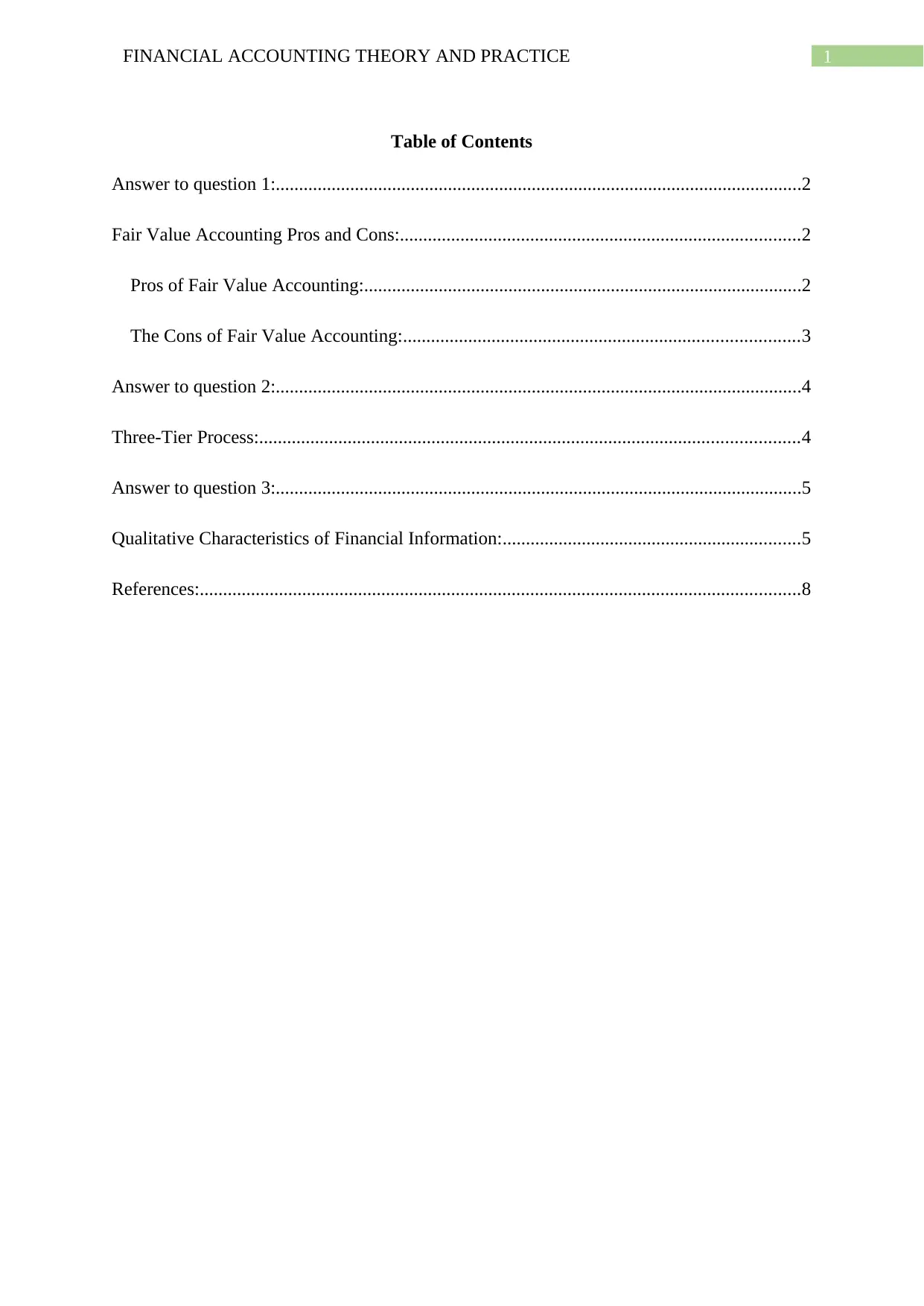
1FINANCIAL ACCOUNTING THEORY AND PRACTICE
Table of Contents
Answer to question 1:.................................................................................................................2
Fair Value Accounting Pros and Cons:......................................................................................2
Pros of Fair Value Accounting:..............................................................................................2
The Cons of Fair Value Accounting:.....................................................................................3
Answer to question 2:.................................................................................................................4
Three-Tier Process:....................................................................................................................4
Answer to question 3:.................................................................................................................5
Qualitative Characteristics of Financial Information:................................................................5
References:.................................................................................................................................8
Table of Contents
Answer to question 1:.................................................................................................................2
Fair Value Accounting Pros and Cons:......................................................................................2
Pros of Fair Value Accounting:..............................................................................................2
The Cons of Fair Value Accounting:.....................................................................................3
Answer to question 2:.................................................................................................................4
Three-Tier Process:....................................................................................................................4
Answer to question 3:.................................................................................................................5
Qualitative Characteristics of Financial Information:................................................................5
References:.................................................................................................................................8
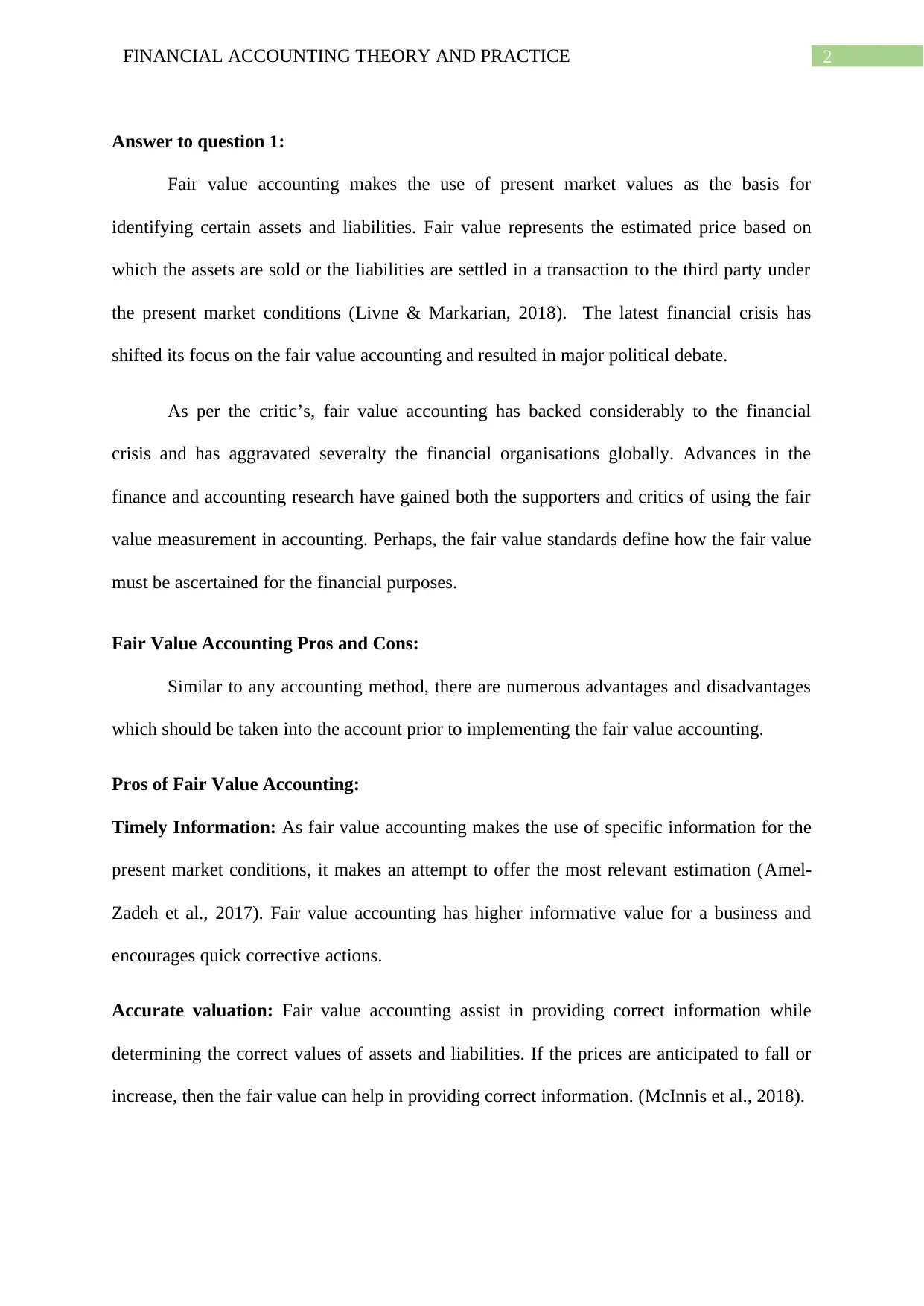
2FINANCIAL ACCOUNTING THEORY AND PRACTICE
Answer to question 1:
Fair value accounting makes the use of present market values as the basis for
identifying certain assets and liabilities. Fair value represents the estimated price based on
which the assets are sold or the liabilities are settled in a transaction to the third party under
the present market conditions (Livne & Markarian, 2018). The latest financial crisis has
shifted its focus on the fair value accounting and resulted in major political debate.
As per the critic’s, fair value accounting has backed considerably to the financial
crisis and has aggravated severalty the financial organisations globally. Advances in the
finance and accounting research have gained both the supporters and critics of using the fair
value measurement in accounting. Perhaps, the fair value standards define how the fair value
must be ascertained for the financial purposes.
Fair Value Accounting Pros and Cons:
Similar to any accounting method, there are numerous advantages and disadvantages
which should be taken into the account prior to implementing the fair value accounting.
Pros of Fair Value Accounting:
Timely Information: As fair value accounting makes the use of specific information for the
present market conditions, it makes an attempt to offer the most relevant estimation (Amel-
Zadeh et al., 2017). Fair value accounting has higher informative value for a business and
encourages quick corrective actions.
Accurate valuation: Fair value accounting assist in providing correct information while
determining the correct values of assets and liabilities. If the prices are anticipated to fall or
increase, then the fair value can help in providing correct information. (McInnis et al., 2018).
Answer to question 1:
Fair value accounting makes the use of present market values as the basis for
identifying certain assets and liabilities. Fair value represents the estimated price based on
which the assets are sold or the liabilities are settled in a transaction to the third party under
the present market conditions (Livne & Markarian, 2018). The latest financial crisis has
shifted its focus on the fair value accounting and resulted in major political debate.
As per the critic’s, fair value accounting has backed considerably to the financial
crisis and has aggravated severalty the financial organisations globally. Advances in the
finance and accounting research have gained both the supporters and critics of using the fair
value measurement in accounting. Perhaps, the fair value standards define how the fair value
must be ascertained for the financial purposes.
Fair Value Accounting Pros and Cons:
Similar to any accounting method, there are numerous advantages and disadvantages
which should be taken into the account prior to implementing the fair value accounting.
Pros of Fair Value Accounting:
Timely Information: As fair value accounting makes the use of specific information for the
present market conditions, it makes an attempt to offer the most relevant estimation (Amel-
Zadeh et al., 2017). Fair value accounting has higher informative value for a business and
encourages quick corrective actions.
Accurate valuation: Fair value accounting assist in providing correct information while
determining the correct values of assets and liabilities. If the prices are anticipated to fall or
increase, then the fair value can help in providing correct information. (McInnis et al., 2018).
⊘ This is a preview!⊘
Do you want full access?
Subscribe today to unlock all pages.

Trusted by 1+ million students worldwide
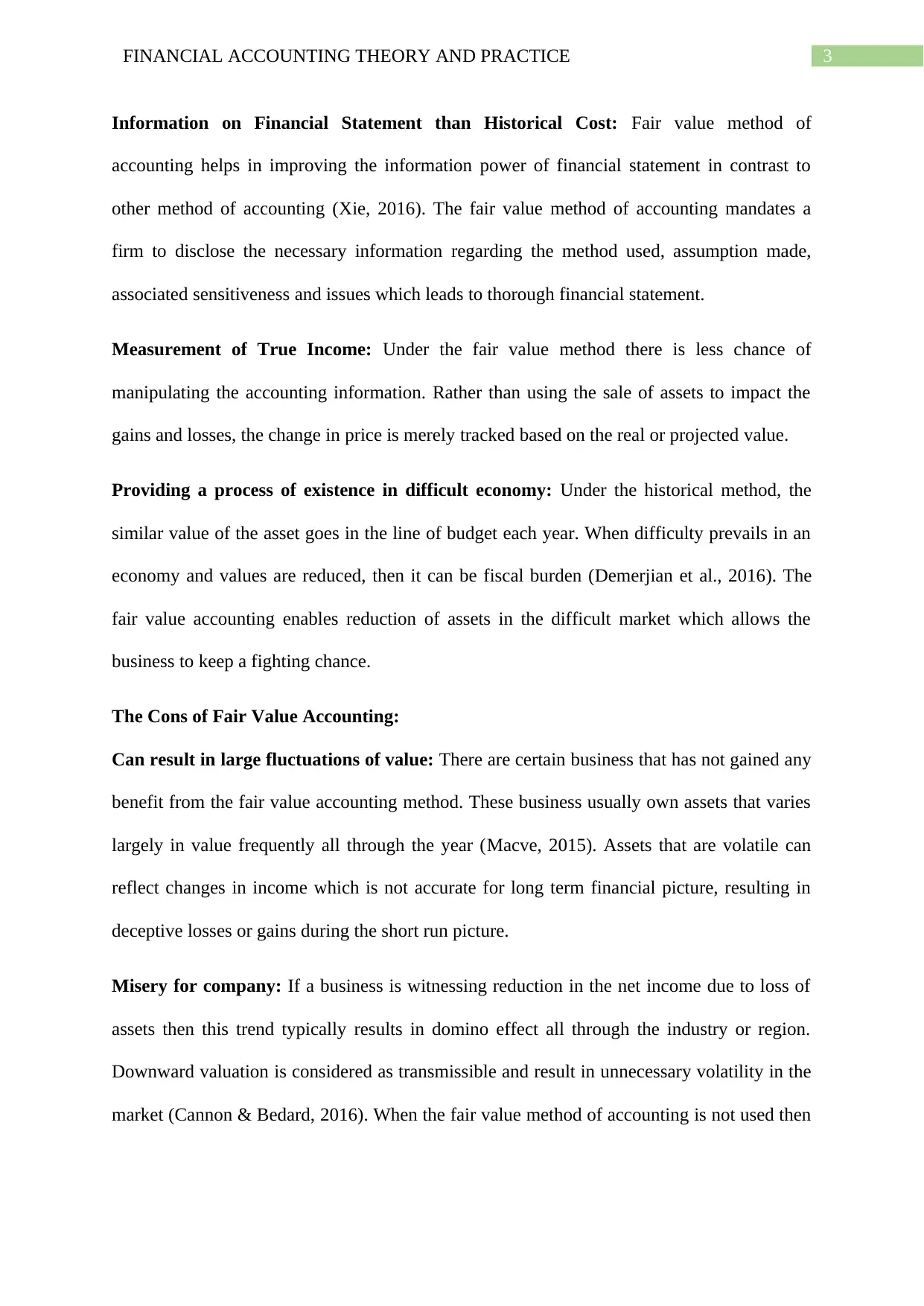
3FINANCIAL ACCOUNTING THEORY AND PRACTICE
Information on Financial Statement than Historical Cost: Fair value method of
accounting helps in improving the information power of financial statement in contrast to
other method of accounting (Xie, 2016). The fair value method of accounting mandates a
firm to disclose the necessary information regarding the method used, assumption made,
associated sensitiveness and issues which leads to thorough financial statement.
Measurement of True Income: Under the fair value method there is less chance of
manipulating the accounting information. Rather than using the sale of assets to impact the
gains and losses, the change in price is merely tracked based on the real or projected value.
Providing a process of existence in difficult economy: Under the historical method, the
similar value of the asset goes in the line of budget each year. When difficulty prevails in an
economy and values are reduced, then it can be fiscal burden (Demerjian et al., 2016). The
fair value accounting enables reduction of assets in the difficult market which allows the
business to keep a fighting chance.
The Cons of Fair Value Accounting:
Can result in large fluctuations of value: There are certain business that has not gained any
benefit from the fair value accounting method. These business usually own assets that varies
largely in value frequently all through the year (Macve, 2015). Assets that are volatile can
reflect changes in income which is not accurate for long term financial picture, resulting in
deceptive losses or gains during the short run picture.
Misery for company: If a business is witnessing reduction in the net income due to loss of
assets then this trend typically results in domino effect all through the industry or region.
Downward valuation is considered as transmissible and result in unnecessary volatility in the
market (Cannon & Bedard, 2016). When the fair value method of accounting is not used then
Information on Financial Statement than Historical Cost: Fair value method of
accounting helps in improving the information power of financial statement in contrast to
other method of accounting (Xie, 2016). The fair value method of accounting mandates a
firm to disclose the necessary information regarding the method used, assumption made,
associated sensitiveness and issues which leads to thorough financial statement.
Measurement of True Income: Under the fair value method there is less chance of
manipulating the accounting information. Rather than using the sale of assets to impact the
gains and losses, the change in price is merely tracked based on the real or projected value.
Providing a process of existence in difficult economy: Under the historical method, the
similar value of the asset goes in the line of budget each year. When difficulty prevails in an
economy and values are reduced, then it can be fiscal burden (Demerjian et al., 2016). The
fair value accounting enables reduction of assets in the difficult market which allows the
business to keep a fighting chance.
The Cons of Fair Value Accounting:
Can result in large fluctuations of value: There are certain business that has not gained any
benefit from the fair value accounting method. These business usually own assets that varies
largely in value frequently all through the year (Macve, 2015). Assets that are volatile can
reflect changes in income which is not accurate for long term financial picture, resulting in
deceptive losses or gains during the short run picture.
Misery for company: If a business is witnessing reduction in the net income due to loss of
assets then this trend typically results in domino effect all through the industry or region.
Downward valuation is considered as transmissible and result in unnecessary volatility in the
market (Cannon & Bedard, 2016). When the fair value method of accounting is not used then
Paraphrase This Document
Need a fresh take? Get an instant paraphrase of this document with our AI Paraphraser
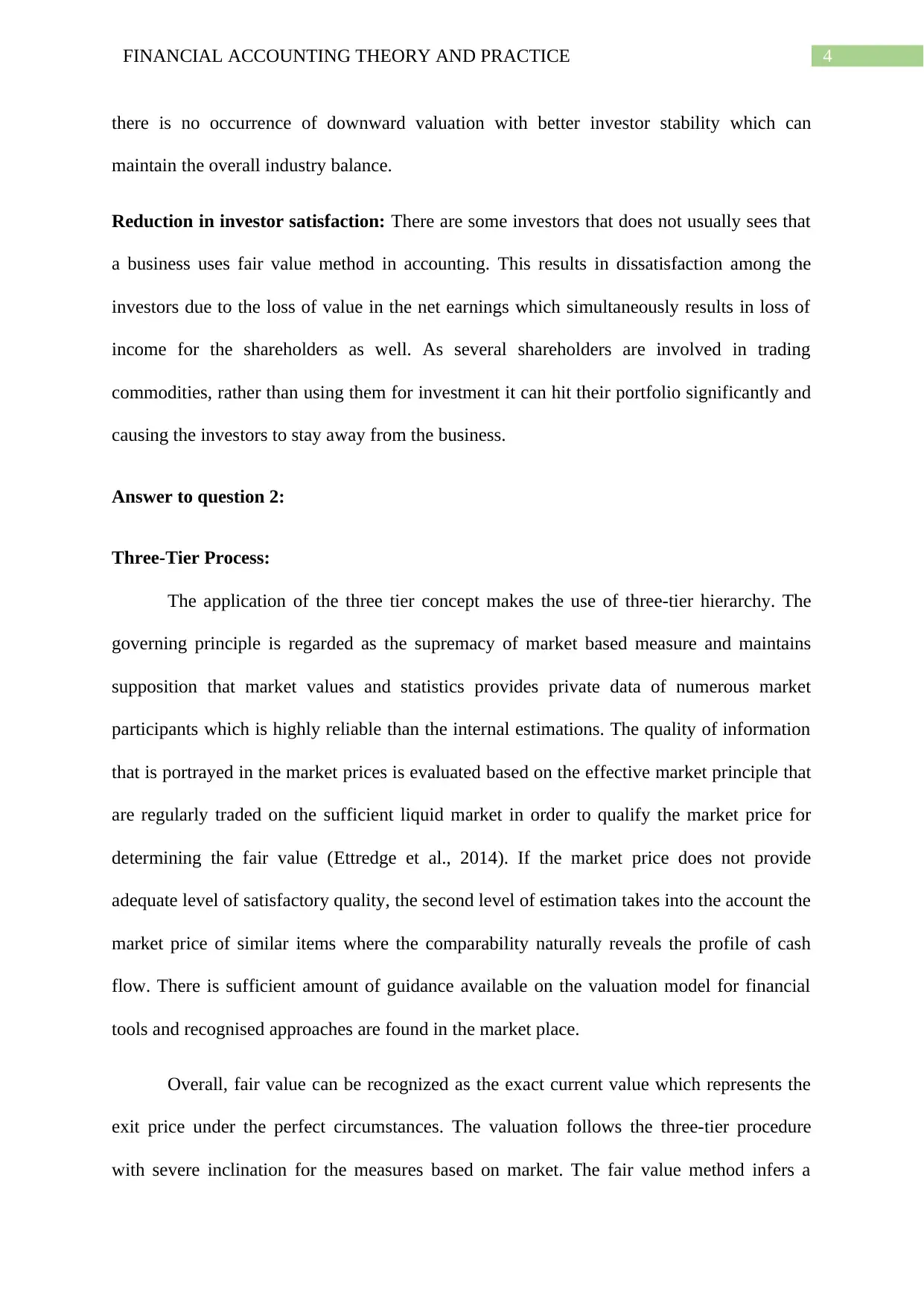
4FINANCIAL ACCOUNTING THEORY AND PRACTICE
there is no occurrence of downward valuation with better investor stability which can
maintain the overall industry balance.
Reduction in investor satisfaction: There are some investors that does not usually sees that
a business uses fair value method in accounting. This results in dissatisfaction among the
investors due to the loss of value in the net earnings which simultaneously results in loss of
income for the shareholders as well. As several shareholders are involved in trading
commodities, rather than using them for investment it can hit their portfolio significantly and
causing the investors to stay away from the business.
Answer to question 2:
Three-Tier Process:
The application of the three tier concept makes the use of three-tier hierarchy. The
governing principle is regarded as the supremacy of market based measure and maintains
supposition that market values and statistics provides private data of numerous market
participants which is highly reliable than the internal estimations. The quality of information
that is portrayed in the market prices is evaluated based on the effective market principle that
are regularly traded on the sufficient liquid market in order to qualify the market price for
determining the fair value (Ettredge et al., 2014). If the market price does not provide
adequate level of satisfactory quality, the second level of estimation takes into the account the
market price of similar items where the comparability naturally reveals the profile of cash
flow. There is sufficient amount of guidance available on the valuation model for financial
tools and recognised approaches are found in the market place.
Overall, fair value can be recognized as the exact current value which represents the
exit price under the perfect circumstances. The valuation follows the three-tier procedure
with severe inclination for the measures based on market. The fair value method infers a
there is no occurrence of downward valuation with better investor stability which can
maintain the overall industry balance.
Reduction in investor satisfaction: There are some investors that does not usually sees that
a business uses fair value method in accounting. This results in dissatisfaction among the
investors due to the loss of value in the net earnings which simultaneously results in loss of
income for the shareholders as well. As several shareholders are involved in trading
commodities, rather than using them for investment it can hit their portfolio significantly and
causing the investors to stay away from the business.
Answer to question 2:
Three-Tier Process:
The application of the three tier concept makes the use of three-tier hierarchy. The
governing principle is regarded as the supremacy of market based measure and maintains
supposition that market values and statistics provides private data of numerous market
participants which is highly reliable than the internal estimations. The quality of information
that is portrayed in the market prices is evaluated based on the effective market principle that
are regularly traded on the sufficient liquid market in order to qualify the market price for
determining the fair value (Ettredge et al., 2014). If the market price does not provide
adequate level of satisfactory quality, the second level of estimation takes into the account the
market price of similar items where the comparability naturally reveals the profile of cash
flow. There is sufficient amount of guidance available on the valuation model for financial
tools and recognised approaches are found in the market place.
Overall, fair value can be recognized as the exact current value which represents the
exit price under the perfect circumstances. The valuation follows the three-tier procedure
with severe inclination for the measures based on market. The fair value method infers a
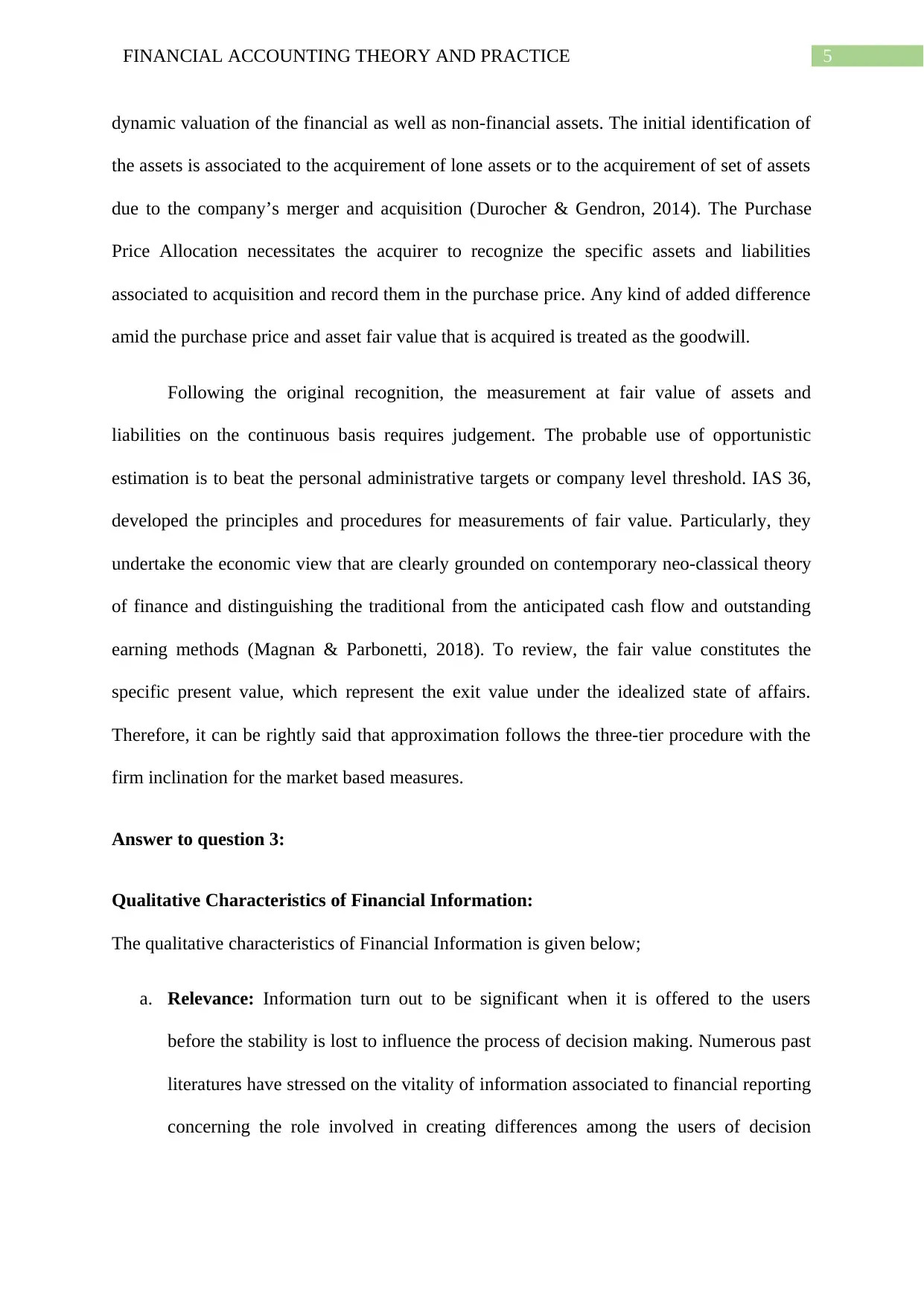
5FINANCIAL ACCOUNTING THEORY AND PRACTICE
dynamic valuation of the financial as well as non-financial assets. The initial identification of
the assets is associated to the acquirement of lone assets or to the acquirement of set of assets
due to the company’s merger and acquisition (Durocher & Gendron, 2014). The Purchase
Price Allocation necessitates the acquirer to recognize the specific assets and liabilities
associated to acquisition and record them in the purchase price. Any kind of added difference
amid the purchase price and asset fair value that is acquired is treated as the goodwill.
Following the original recognition, the measurement at fair value of assets and
liabilities on the continuous basis requires judgement. The probable use of opportunistic
estimation is to beat the personal administrative targets or company level threshold. IAS 36,
developed the principles and procedures for measurements of fair value. Particularly, they
undertake the economic view that are clearly grounded on contemporary neo-classical theory
of finance and distinguishing the traditional from the anticipated cash flow and outstanding
earning methods (Magnan & Parbonetti, 2018). To review, the fair value constitutes the
specific present value, which represent the exit value under the idealized state of affairs.
Therefore, it can be rightly said that approximation follows the three-tier procedure with the
firm inclination for the market based measures.
Answer to question 3:
Qualitative Characteristics of Financial Information:
The qualitative characteristics of Financial Information is given below;
a. Relevance: Information turn out to be significant when it is offered to the users
before the stability is lost to influence the process of decision making. Numerous past
literatures have stressed on the vitality of information associated to financial reporting
concerning the role involved in creating differences among the users of decision
dynamic valuation of the financial as well as non-financial assets. The initial identification of
the assets is associated to the acquirement of lone assets or to the acquirement of set of assets
due to the company’s merger and acquisition (Durocher & Gendron, 2014). The Purchase
Price Allocation necessitates the acquirer to recognize the specific assets and liabilities
associated to acquisition and record them in the purchase price. Any kind of added difference
amid the purchase price and asset fair value that is acquired is treated as the goodwill.
Following the original recognition, the measurement at fair value of assets and
liabilities on the continuous basis requires judgement. The probable use of opportunistic
estimation is to beat the personal administrative targets or company level threshold. IAS 36,
developed the principles and procedures for measurements of fair value. Particularly, they
undertake the economic view that are clearly grounded on contemporary neo-classical theory
of finance and distinguishing the traditional from the anticipated cash flow and outstanding
earning methods (Magnan & Parbonetti, 2018). To review, the fair value constitutes the
specific present value, which represent the exit value under the idealized state of affairs.
Therefore, it can be rightly said that approximation follows the three-tier procedure with the
firm inclination for the market based measures.
Answer to question 3:
Qualitative Characteristics of Financial Information:
The qualitative characteristics of Financial Information is given below;
a. Relevance: Information turn out to be significant when it is offered to the users
before the stability is lost to influence the process of decision making. Numerous past
literatures have stressed on the vitality of information associated to financial reporting
concerning the role involved in creating differences among the users of decision
⊘ This is a preview!⊘
Do you want full access?
Subscribe today to unlock all pages.

Trusted by 1+ million students worldwide
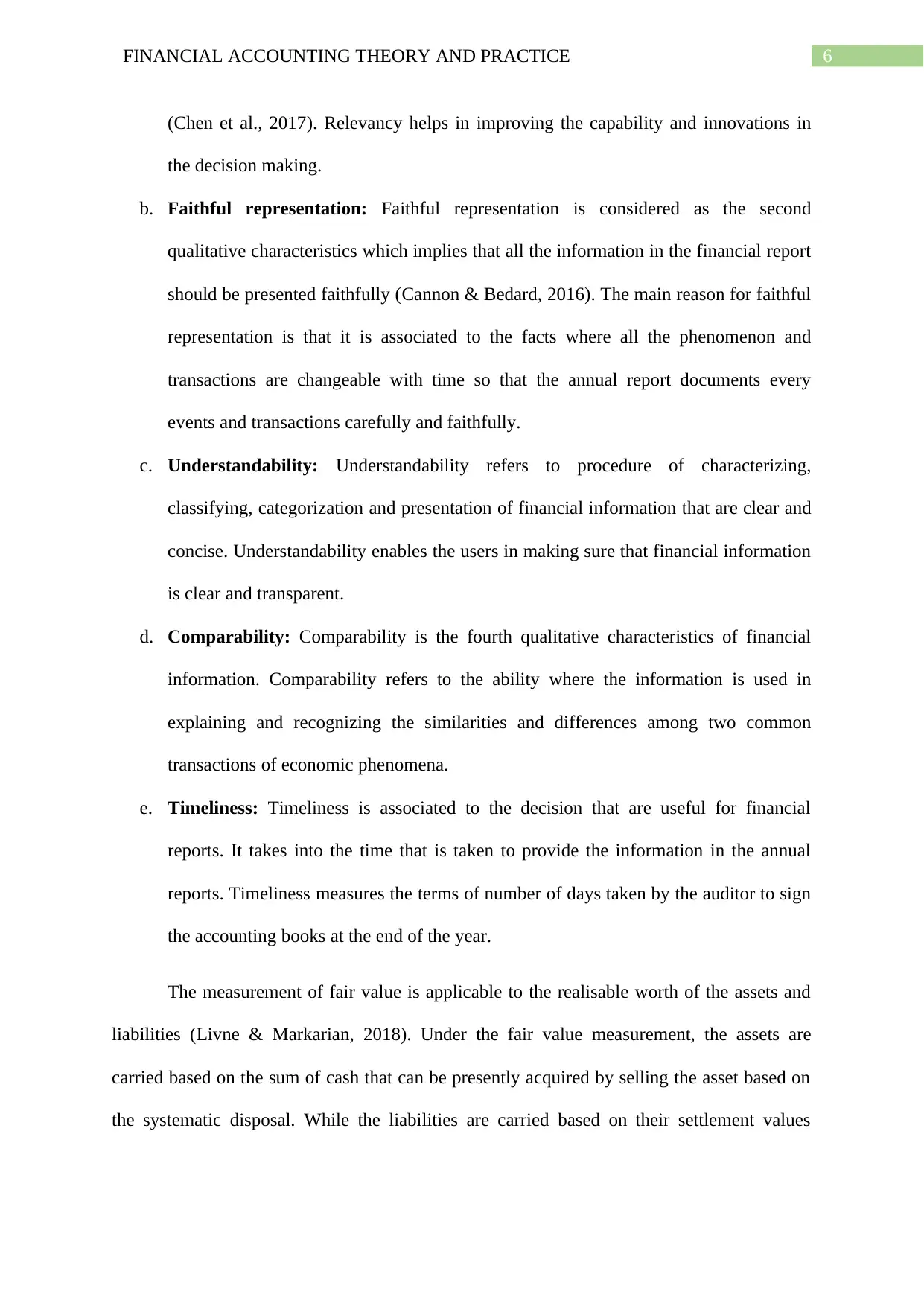
6FINANCIAL ACCOUNTING THEORY AND PRACTICE
(Chen et al., 2017). Relevancy helps in improving the capability and innovations in
the decision making.
b. Faithful representation: Faithful representation is considered as the second
qualitative characteristics which implies that all the information in the financial report
should be presented faithfully (Cannon & Bedard, 2016). The main reason for faithful
representation is that it is associated to the facts where all the phenomenon and
transactions are changeable with time so that the annual report documents every
events and transactions carefully and faithfully.
c. Understandability: Understandability refers to procedure of characterizing,
classifying, categorization and presentation of financial information that are clear and
concise. Understandability enables the users in making sure that financial information
is clear and transparent.
d. Comparability: Comparability is the fourth qualitative characteristics of financial
information. Comparability refers to the ability where the information is used in
explaining and recognizing the similarities and differences among two common
transactions of economic phenomena.
e. Timeliness: Timeliness is associated to the decision that are useful for financial
reports. It takes into the time that is taken to provide the information in the annual
reports. Timeliness measures the terms of number of days taken by the auditor to sign
the accounting books at the end of the year.
The measurement of fair value is applicable to the realisable worth of the assets and
liabilities (Livne & Markarian, 2018). Under the fair value measurement, the assets are
carried based on the sum of cash that can be presently acquired by selling the asset based on
the systematic disposal. While the liabilities are carried based on their settlement values
(Chen et al., 2017). Relevancy helps in improving the capability and innovations in
the decision making.
b. Faithful representation: Faithful representation is considered as the second
qualitative characteristics which implies that all the information in the financial report
should be presented faithfully (Cannon & Bedard, 2016). The main reason for faithful
representation is that it is associated to the facts where all the phenomenon and
transactions are changeable with time so that the annual report documents every
events and transactions carefully and faithfully.
c. Understandability: Understandability refers to procedure of characterizing,
classifying, categorization and presentation of financial information that are clear and
concise. Understandability enables the users in making sure that financial information
is clear and transparent.
d. Comparability: Comparability is the fourth qualitative characteristics of financial
information. Comparability refers to the ability where the information is used in
explaining and recognizing the similarities and differences among two common
transactions of economic phenomena.
e. Timeliness: Timeliness is associated to the decision that are useful for financial
reports. It takes into the time that is taken to provide the information in the annual
reports. Timeliness measures the terms of number of days taken by the auditor to sign
the accounting books at the end of the year.
The measurement of fair value is applicable to the realisable worth of the assets and
liabilities (Livne & Markarian, 2018). Under the fair value measurement, the assets are
carried based on the sum of cash that can be presently acquired by selling the asset based on
the systematic disposal. While the liabilities are carried based on their settlement values
Paraphrase This Document
Need a fresh take? Get an instant paraphrase of this document with our AI Paraphraser
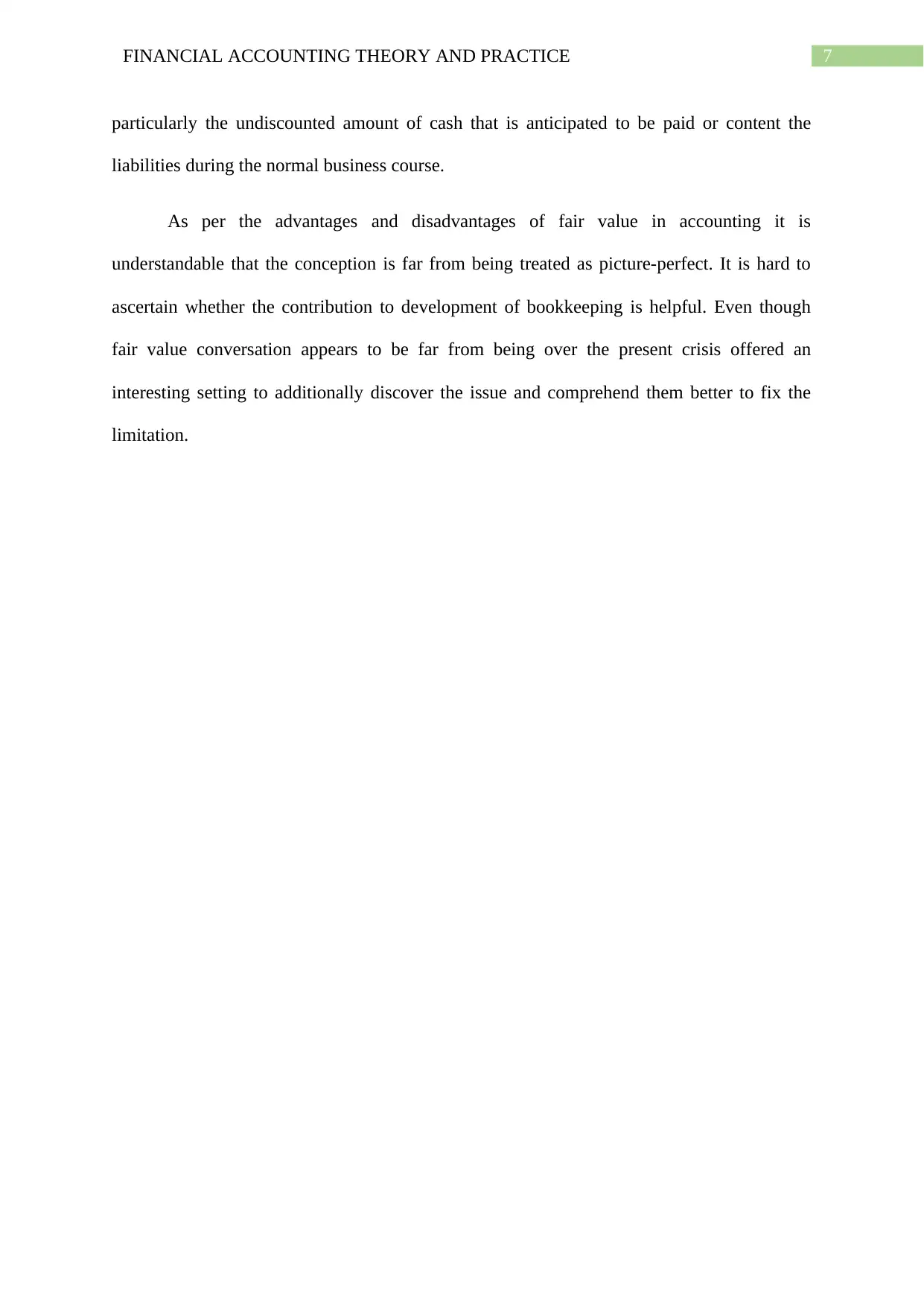
7FINANCIAL ACCOUNTING THEORY AND PRACTICE
particularly the undiscounted amount of cash that is anticipated to be paid or content the
liabilities during the normal business course.
As per the advantages and disadvantages of fair value in accounting it is
understandable that the conception is far from being treated as picture-perfect. It is hard to
ascertain whether the contribution to development of bookkeeping is helpful. Even though
fair value conversation appears to be far from being over the present crisis offered an
interesting setting to additionally discover the issue and comprehend them better to fix the
limitation.
particularly the undiscounted amount of cash that is anticipated to be paid or content the
liabilities during the normal business course.
As per the advantages and disadvantages of fair value in accounting it is
understandable that the conception is far from being treated as picture-perfect. It is hard to
ascertain whether the contribution to development of bookkeeping is helpful. Even though
fair value conversation appears to be far from being over the present crisis offered an
interesting setting to additionally discover the issue and comprehend them better to fix the
limitation.
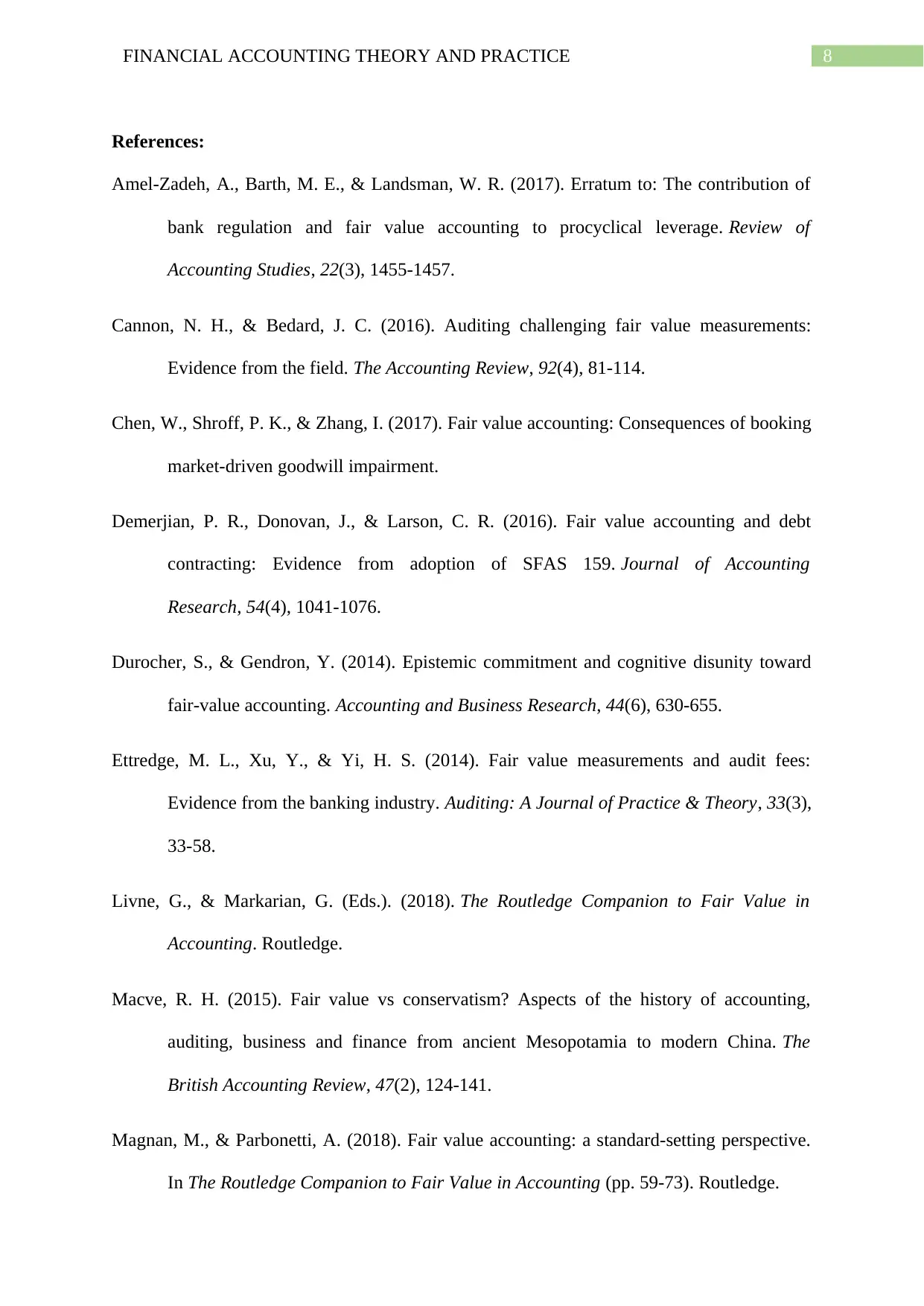
8FINANCIAL ACCOUNTING THEORY AND PRACTICE
References:
Amel-Zadeh, A., Barth, M. E., & Landsman, W. R. (2017). Erratum to: The contribution of
bank regulation and fair value accounting to procyclical leverage. Review of
Accounting Studies, 22(3), 1455-1457.
Cannon, N. H., & Bedard, J. C. (2016). Auditing challenging fair value measurements:
Evidence from the field. The Accounting Review, 92(4), 81-114.
Chen, W., Shroff, P. K., & Zhang, I. (2017). Fair value accounting: Consequences of booking
market-driven goodwill impairment.
Demerjian, P. R., Donovan, J., & Larson, C. R. (2016). Fair value accounting and debt
contracting: Evidence from adoption of SFAS 159. Journal of Accounting
Research, 54(4), 1041-1076.
Durocher, S., & Gendron, Y. (2014). Epistemic commitment and cognitive disunity toward
fair-value accounting. Accounting and Business Research, 44(6), 630-655.
Ettredge, M. L., Xu, Y., & Yi, H. S. (2014). Fair value measurements and audit fees:
Evidence from the banking industry. Auditing: A Journal of Practice & Theory, 33(3),
33-58.
Livne, G., & Markarian, G. (Eds.). (2018). The Routledge Companion to Fair Value in
Accounting. Routledge.
Macve, R. H. (2015). Fair value vs conservatism? Aspects of the history of accounting,
auditing, business and finance from ancient Mesopotamia to modern China. The
British Accounting Review, 47(2), 124-141.
Magnan, M., & Parbonetti, A. (2018). Fair value accounting: a standard-setting perspective.
In The Routledge Companion to Fair Value in Accounting (pp. 59-73). Routledge.
References:
Amel-Zadeh, A., Barth, M. E., & Landsman, W. R. (2017). Erratum to: The contribution of
bank regulation and fair value accounting to procyclical leverage. Review of
Accounting Studies, 22(3), 1455-1457.
Cannon, N. H., & Bedard, J. C. (2016). Auditing challenging fair value measurements:
Evidence from the field. The Accounting Review, 92(4), 81-114.
Chen, W., Shroff, P. K., & Zhang, I. (2017). Fair value accounting: Consequences of booking
market-driven goodwill impairment.
Demerjian, P. R., Donovan, J., & Larson, C. R. (2016). Fair value accounting and debt
contracting: Evidence from adoption of SFAS 159. Journal of Accounting
Research, 54(4), 1041-1076.
Durocher, S., & Gendron, Y. (2014). Epistemic commitment and cognitive disunity toward
fair-value accounting. Accounting and Business Research, 44(6), 630-655.
Ettredge, M. L., Xu, Y., & Yi, H. S. (2014). Fair value measurements and audit fees:
Evidence from the banking industry. Auditing: A Journal of Practice & Theory, 33(3),
33-58.
Livne, G., & Markarian, G. (Eds.). (2018). The Routledge Companion to Fair Value in
Accounting. Routledge.
Macve, R. H. (2015). Fair value vs conservatism? Aspects of the history of accounting,
auditing, business and finance from ancient Mesopotamia to modern China. The
British Accounting Review, 47(2), 124-141.
Magnan, M., & Parbonetti, A. (2018). Fair value accounting: a standard-setting perspective.
In The Routledge Companion to Fair Value in Accounting (pp. 59-73). Routledge.
⊘ This is a preview!⊘
Do you want full access?
Subscribe today to unlock all pages.

Trusted by 1+ million students worldwide
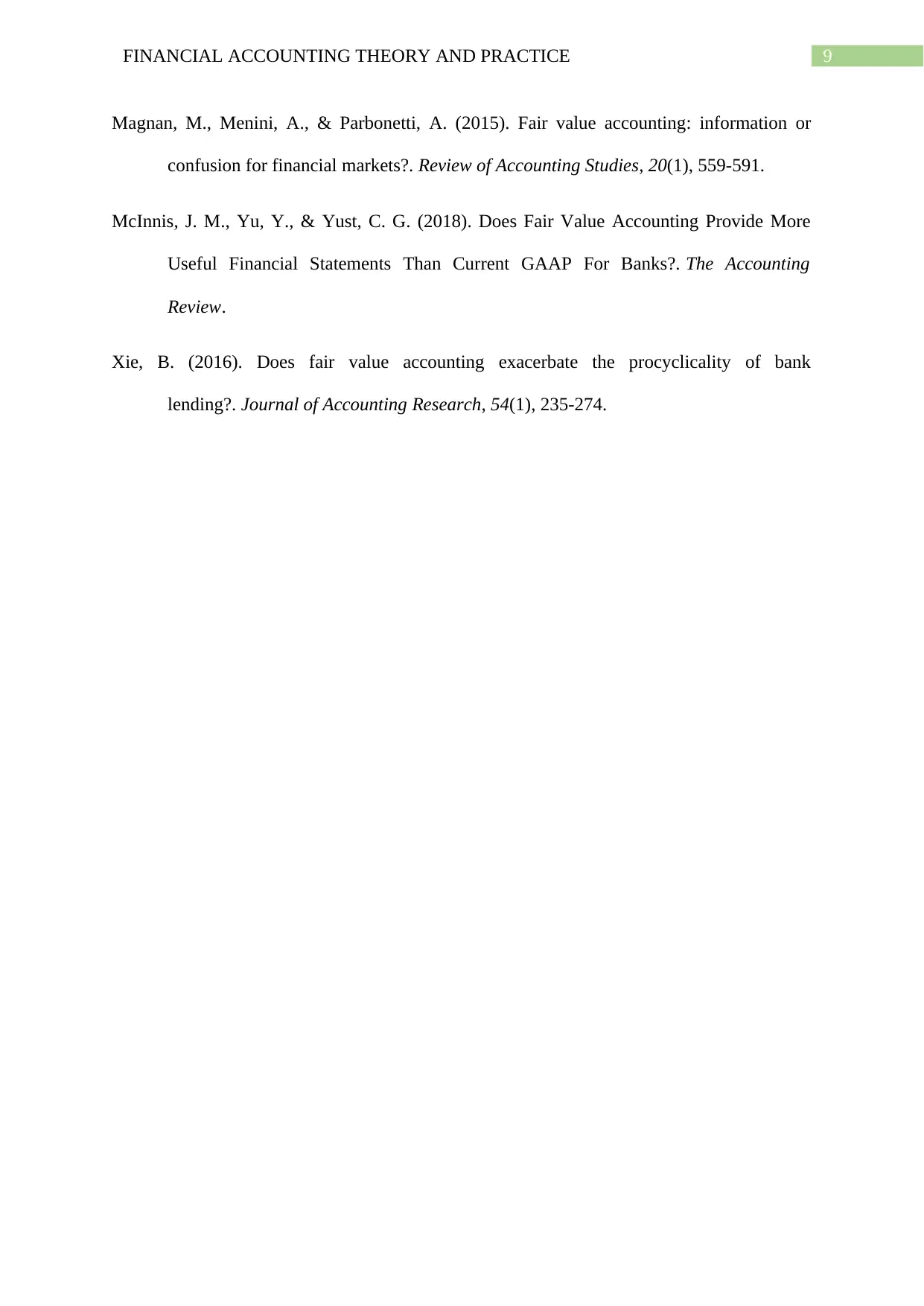
9FINANCIAL ACCOUNTING THEORY AND PRACTICE
Magnan, M., Menini, A., & Parbonetti, A. (2015). Fair value accounting: information or
confusion for financial markets?. Review of Accounting Studies, 20(1), 559-591.
McInnis, J. M., Yu, Y., & Yust, C. G. (2018). Does Fair Value Accounting Provide More
Useful Financial Statements Than Current GAAP For Banks?. The Accounting
Review.
Xie, B. (2016). Does fair value accounting exacerbate the procyclicality of bank
lending?. Journal of Accounting Research, 54(1), 235-274.
Magnan, M., Menini, A., & Parbonetti, A. (2015). Fair value accounting: information or
confusion for financial markets?. Review of Accounting Studies, 20(1), 559-591.
McInnis, J. M., Yu, Y., & Yust, C. G. (2018). Does Fair Value Accounting Provide More
Useful Financial Statements Than Current GAAP For Banks?. The Accounting
Review.
Xie, B. (2016). Does fair value accounting exacerbate the procyclicality of bank
lending?. Journal of Accounting Research, 54(1), 235-274.
1 out of 10
Related Documents
Your All-in-One AI-Powered Toolkit for Academic Success.
+13062052269
info@desklib.com
Available 24*7 on WhatsApp / Email
![[object Object]](/_next/static/media/star-bottom.7253800d.svg)
Unlock your academic potential
Copyright © 2020–2025 A2Z Services. All Rights Reserved. Developed and managed by ZUCOL.





